| Article ID | Journal | Published Year | Pages | File Type |
|---|---|---|---|---|
| 8067069 | Annals of Nuclear Energy | 2018 | 15 Pages |
Abstract
Nuclear power plants should be capable of contributing safely and flexibly to the electrical grid stability. This research deliberates the feasibility of a new innovative concept of a passive and autonomous frequency control operation (PAFO) in soluble-boron-free (SBF) pressurized water reactors (PWRs). The new concept eliminates any required active control in the reactor core for attaining primary and secondary frequency control operational modes in PWRs. In particular, control rods and soluble-boron are not utilized in a PAFO. Meanwhile, the reactor power maneuvering is achieved entirely by the passive reactor feedback to the coolant temperature change. This approach is motivated by the strongly negative coolant temperature coefficient available in an SBF coolant system. In order to ascertain judiciously the practical viability of the proposed concept, numerical simulations of passive primary and secondary frequency operations are performed using a lumped PWR system model solved by an in-house FORTRAN-95 computer code. The various simulation parameters are obtained from 3D Monte Carlo simulations of an SBF 450â¯MWt PWR by using Serpent-2 code with ENDF/B-7.1 data library. The numerical simulations are carried out at the beginning, middle and end of the fuel cycle to emphasize the effect of fuel burnup on the proposed PAFO. Moreover, sensitivity analyses on xenon worth and nominal fuel temperature are performed to deliberate their impacts in tailoring the reactor performance. Because the reactor power matches well with the power demand with a small variation in coolant temperature during the frequency control, we conclude that there is promising potential for the proposed PAFO concept.
Related Topics
Physical Sciences and Engineering
Energy
Energy Engineering and Power Technology
Authors
Ahmed Amin E. Abdelhameed, Xuan Ha Nguyen, Jeongik Lee, Yonghee Kim,
